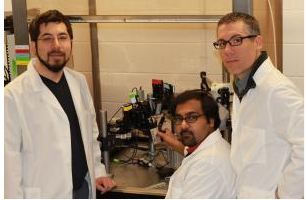
© Georgia TechNeuromatic Devices research team
The new automated process is faster than traditional method while delivering comparable results
MIT and Georgia Institute of Technology researchers have created a new automated method that pinpoints certain characteristics of neurons in the brain.
The research was conducted by Ed Boyden, associate professor of biological engineering and brain and cognitive sciences at MIT; Craig Forest, an assistant professor in the George W. Woodruff School of Mechanical Engineering at Georgia Tech, and Suhasa Kodandaramaiah, a graduate student. The three developed the new automated process for dissecting the inner mechanics of neurons in the brain.
The researchers based their new automated technique off of a 30-year-old method called whole-cell patch clamping. Whole-cell patch clamping involved a hollow glass pipette, which touches the cell membrane of a neuron. Upon contact the pipette opens up a small pore in the membrane. Then electrical activity within the cell is recorded.
The problem with traditional whole-cell patch clamping is that it isn't an easy process. It takes researchers months to learn. While Kodandaramaiah was learning the difficult process, he said he was thinking of a process where robots take over the painstaking method for a more accurate and faster way of learning about neurons.
To automate the process, the three researchers built a robotic arm capable of directing the glass pipette into a mouse brain. The system works by using the robotic arm to move the pipette through cells in the brain as it measures electrical impedance, which is a measure of how challenging it is for electricity to flow out of the pipette. When there are no cells near the pipette, electricity flows and impedance is low, but when the pipette encounters a cell, electricity cannot flow and and imedance increases.
The pipette takes two-micrometer steps and measures impedance 10 times per second. When it encounters a cell, it stops itself from poking the membrane. However, it does use suction to form a seal with the membrane. It then uses an electrode to penetrate the membrane, and begins recording the cell's internal electrical activity.
According to the research team, the automated process is capable of detecting cells with 90 percent accuracy, and can establish a connection with these cells 40 percent of the time.
This process can also be used to identify the shape of a cell by injecting dyes. The researchers are also looking to use the process with a larger number of electrodes so that they can record activity from several neurons at once.
The next step is to commercialize the device. The three researchers are already working on this by creating their own startup company called Neuromatic Devices.
"Our team has been interdisciplinary from the beginning, and this has enabled us to bring the principles of precision machine design to bear upon the study of the living brain," said Forest. "If you really want to know what a neuron is, you can look at the shape, and you can look at how it fires. Then if you pull out the genetic information, you can really know what's going on. Now you know everything. That's the whole picture."
This automated process could potentially help those with brain disorders like schizophrenia, autism and Parkinson's disease because the technique could allow researchers to distinguish between abnormal and normal cells.
Reader Comments
to our Newsletter